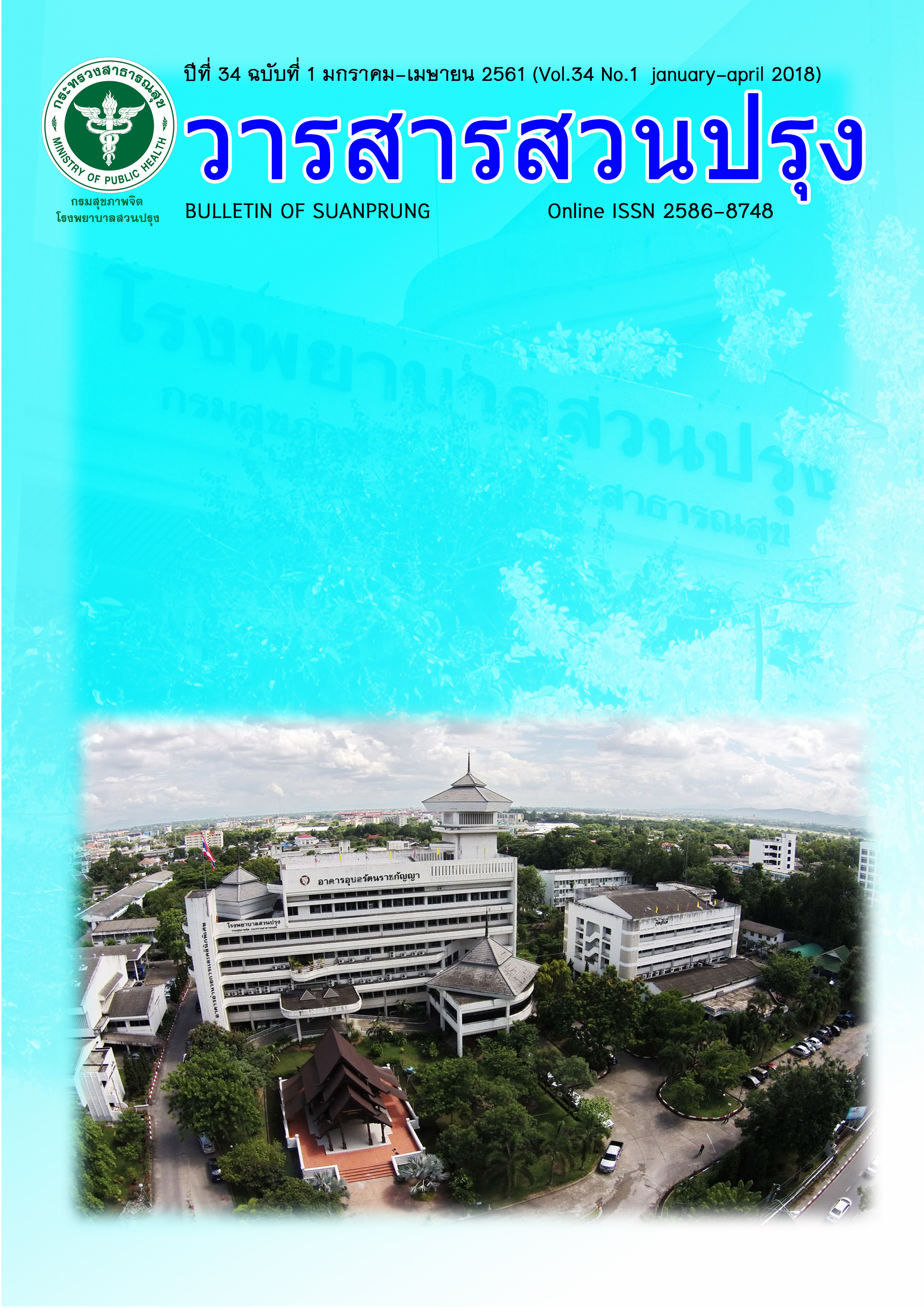REDUCING THE SERVICE TIME FOR PSYCHIATRIC HOSPITALS USING SIMULATION TECHNIQUE
Main Article Content
Abstract
Objective: To reduce the time of service for outpatients of the Nakhonratchasima Rajanagarindra psychiatric hospital by developing a software for simulating the queuing model.
Method: This research applied the System Development Life Cycle (SDLC) for designing and developing a queuing model simulator (or queuing model software) using simulation technique and problem analysis based on queuing theory. It focused on the overall service time for three outpatient cases: new cases, visited cases, and repeat medication cases.
Results: The simulation results indicated that the proposed approach has potential to reduce the overall service time by more than 10 per cent in each case. There are 21.83 per cent or 31.30-minute reduction of overall service time for the new cases (decreased from 142.49 minutes to 111.19 minutes), 25.93 per cent or 21.30-minute reduction of overall service time for the visited cases (decreased from 81.26 minutes to 59.56 minutes) and 33.33 per cent or 15.10-minute reduction of overall service time for the repeat medication cases (decreased from 45.54 minutes to 30.44 minutes). Moreover, the usability evaluation of developed software revealed that the overall evaluation is in a very good level.
Conclusion: There are condition variables in the developed software that can be adjusted to discover the best approaches for reducing the overall service time.
Keywords: Service time, Psychiatric hospital, Simulation techniques
วัตถุประสงค์ เพื่อลดระยะเวลาการให้บริการสำหรับผู้ป่วยนอกโรงพยาบาลจิตเวชนครราชสีมาราชนครินทร์ โดยการพัฒนาซอฟต์แวร์คอมพิวเตอร์สำหรับการจำลองตัวแบบแถวคอยการรับบริการ
วิธีการศึกษา เป็นการวิจัยออกแบบและพัฒนาตามขั้นตอนของวงจรการพัฒนาระบบ (System Development Life Cycle: SDLC) เพื่อศึกษาการลดระยะเวลาการให้บริการโดยรวมของผู้รับบริการ 3 ประเภท ได้แก่ ผู้รับบริการรายใหม่ รายเก่า และผู้รับบริการยาเดิม โดยอาศัยเทคนิคการจำลองสถานการณ์ด้วยคอมพิวเตอร์และวิเคราะห์ปัญหาตามแนวคิดของทฤษฏีแถวคอย
ผลการศึกษา ได้แนวทางในการลดเวลาให้บริการโดยรวมได้มากกว่าร้อยละ 10 ของผู้รับบริการแต่ละประเภท โดยผู้รับบริการรายใหม่ลดลง 31.30 นาที จากเดิม 142.49 นาที เป็น 111.19 นาที หรือลดลงร้อยละ 21.83 ผู้รับบริการรายเก่าลดลง 21.30 นาที จากเดิม 81.26 นาที เป็น 59.56 นาที หรือลดลงร้อยละ 25.93 และผู้ป่วยรับยาเดิมลดลง 15.10 นาที จากเดิม 45.54 นาที เป็น 30.44 นาที หรือลดลงร้อยละ 33.33 และผลการประเมินความสามารถในการใช้งานของซอฟต์แวร์ที่พัฒนาขึ้นโดยรวมอยู่ในระดับดีมาก
สรุป ซอฟต์แวร์ที่พัฒนาขึ้นสามารถเปลี่ยนแปลงค่าตัวแปรต่าง ๆ เพื่อศึกษาเวลาให้บริการต่าง ๆ ของระบบที่เปลี่ยนไป เพื่อใช้เป็นแนวทางในการปรับปรุงระบบบริการให้มีความเหมาะสมต่อไปได้
คำสำคัญ เวลาให้บริการ โรงพยาบาลจิตเวช เทคนิคการจำลองสถานการณ์
Article Details
บทความหลังผ่านการปรับแก้จากกองบรรณาธิการแล้ว เป็นลิขสิทธ์ของวารสารจิตเวชวิทยาสาร โรงพยาบาลสวนปรุง กรมสุขภาพจิต กระทรวงสาธารณสุข ห้ามเผยแพร่เพื่อประโยชน์ทางการค้าโดยไม่ได้รับอนุญาต แต่อนุญาตให้เผยแพร่บทความดังกล่าวเพื่อประโยชน์ทางการศึกษาแก่ประชาชนทั่วไป ทั้งนี้กองบรรณาธิการไม่จำเป็นต้องเห็นด้วยกับบทความหรือข้อคิดเห็นใดๆ ที่ปรากฏในวารสารสวนปรุง
References
2. E-Occurrence Report. Nakhon Ratchasima Rajanagarindra Psychiatric Hospital. Nakhon Ratchasima; 2011.
3. Frederick S. Hiller, Gerald J. Lieberman. Introduction to Operations Research. Bangkok: Tops; 2005. p.360.
4. Jakob Nielsen. Usability Engineering. USA: Academic press. 1993. Quoted in Eelke Folmer and Jan Bosch. Architecting for usability: a survey. The Journal of Systems and Software. 2004; 70(1-2): p.61-78.
5. Jantra Na Nakorn. A Simulation Technique of Queueing Problem for Outpatient Clinic,KantangHospital, Trang Province. Thailand: Kasetsart University; 2005.
6. Kanchala Sudtachat and Pisit Juathai. Simulation Modeling to Improve the Performances in Queue for Dispense Department. PSU Engineering Conference 2009; 7: p.487-494.
7. Mongkon Wanitphakdeedecha. Quueing System Simulation at OPD Srivichai 3 Hospital. Thailand: Thammasat University; 2002.
8. Nakhon Ratchasima Rajanagarindra Psychiatric Hospital. Annual Report 2010. Nakhon Ratchasima; 2010. p.18.
9. Paritat Silpakit, Suwut Mahatnirunkul, Prayad Prapaporm. Adverse event in psychiatric hospital by Thai HA psychiatric trigger tool. Journal Of Mental Health of Thailand 2010; 18: 139-148. p. 141.
10. Patient Care Team. Nakhon Ratchasima Rajanagarindra Psychiatric Hospital. Nakhon Ratchasima; 2011.
11. Patrick and Puterman. Reducing Wait Times Through Operations Research: The Case for Intelligent Patient Scheduling 2007. [online]. Available from: http://www.sciencedirect.com. [2011 October 1].
12. Saisurang Chotipanich. An Analysis of Queuing System for Vascular Puncture Service, Bhumibol Adlyadej Hospital. Thailand: Kasetsart University; 2004.
13. Sathid Thesarat and Sombat Sindhuchao. Simulation of a Queuing System for Reducing Customer Waiting Time Case study: Trakarn Phuetphon Hospital, Ubon Ratchathani Province 2010. [online]. Available from: http://app.eng.ubu.ac.th/~resproject/upload/p1/23.paper_I_sombat.pdf [2011 October 1].
14. Sattapong Chaichit. Performance Analysis of Out Patient Service System of Pasang Hospital, Lamphun Province Using Queuing Simulation Model. Thailand: Chiang Mai University; 2007.
15. Seung-Chul Kim et al. Flexible bed and allocation and performance in the intensive care unit, Journal of operations management 2000; 18; 427-443.
16. Seung-Chul Kim et al. Scheduling hospital services: the efficacy of elective surgery quotas. The international Journal of Management Science. 2002; 30: 335-346.
17. Syi su. Modeling an emergency medical services system using computer simulation. [Online]. Available from: www.sciencedirect.com. [2010 March 2].
18. Wang, Qinun. Modeling and analysis of high risk patient queue 2002. [online]. Available from: www.sciencedirect.com [2010 March 2].
19. Wanisa Jansri and Montean Rattanasiriwongwutt. Management Information System of I.C.U. for Inpatient after Operating Using Priority of Queuing theory, National Conference on Computing and Information Technology 2009; 5; 767-771.
20. Wannapat Mookdaharn. Analysis of Outpatient Service System in Srinakarin Hospital, Khon Kaen. Thailand: Kasetsart University; 2004.

